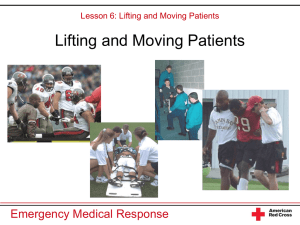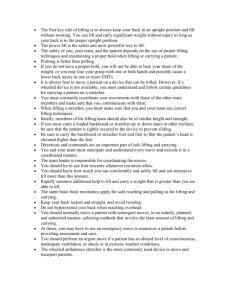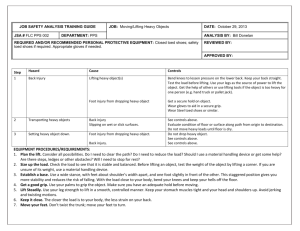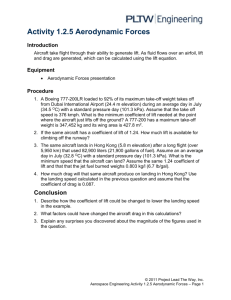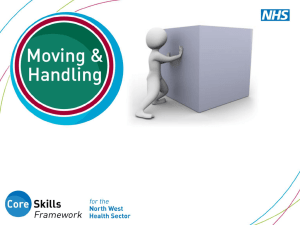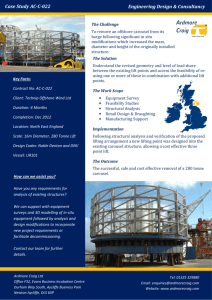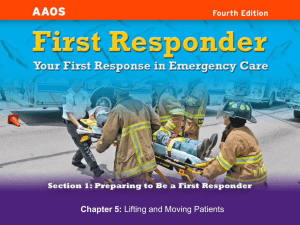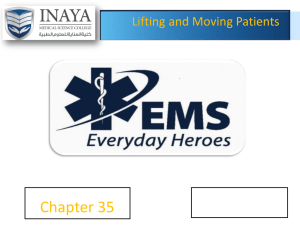Chapter 5 - Toggenburg Ski Patrol
advertisement
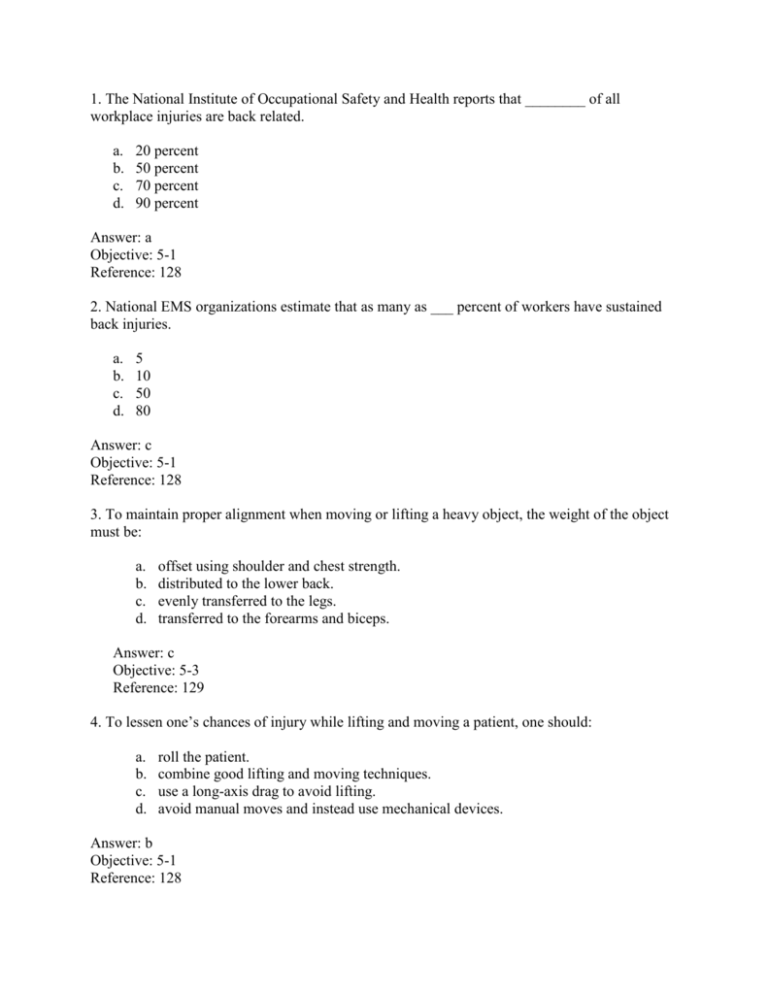
1. The National Institute of Occupational Safety and Health reports that ________ of all workplace injuries are back related. a. b. c. d. 20 percent 50 percent 70 percent 90 percent Answer: a Objective: 5-1 Reference: 128 2. National EMS organizations estimate that as many as ___ percent of workers have sustained back injuries. a. b. c. d. 5 10 50 80 Answer: c Objective: 5-1 Reference: 128 3. To maintain proper alignment when moving or lifting a heavy object, the weight of the object must be: a. b. c. d. offset using shoulder and chest strength. distributed to the lower back. evenly transferred to the legs. transferred to the forearms and biceps. Answer: c Objective: 5-3 Reference: 129 4. To lessen one’s chances of injury while lifting and moving a patient, one should: a. b. c. d. roll the patient. combine good lifting and moving techniques. use a long-axis drag to avoid lifting. avoid manual moves and instead use mechanical devices. Answer: b Objective: 5-1 Reference: 128 5. When a person exhibits good body mechanics and lifts properly, the spine is: a. b. c. d. slightly bent in the upper thoracic region. straight at the thoracic region and bent in the lumbar region. bent at no more than 15 degrees. straight and in an anatomical position. Answer: d Objective: 5-1 Reference: 129 6. Which of the following questions is not of concern when preparing to move or lift a heavy object? a. b. c. d. How heavy is the object? How long will it take to make the move? What type of terrain is involved? Which carrying device will work best? Answer: b Objective: 5-1 Reference: 129 7. Which of the following pieces of equipment do OEC Technicians use most to move, lift, and carry a patient? a. b. c. d. Long spine board (LSB) Orthopedic stretcher Portable stretcher Basket stretcher Answer: a Objective: 5-1 Reference: 131 8. When used correctly, the power grip maximizes the force of the hands, which are placed: a. b. c. d. palms down and 8 inches apart. palms up and 10 inches apart. palms up and 5 inches apart. palms down and 18 inches apart. Answer: b Objective: 5-2 Reference: 142 9. When using the power grip, the hands are: a. b. c. d. placed underneath the lifting device and held loosely. placed underneath the lifting device and held firmly. placed on the side of the lifting device and held firmly. held on the side of the device at a 45-degree angle. Answer: b Objective: 5-2 Reference: 142 10. Which of the following instructions is most important for combining optimal anatomic position with good body mechanics in a power lift? a. b. c. d. Maintain a wide stance (at least 24 inches). Keep your back muscles loose and your head bent forward. Straighten your legs to lift. Squat down and keep your knees outward at a 45-degree angle. Answer: c Objective: 5-3 Reference: 143 11. Extremity lifts may not be tolerated by: a. b. c. d. obese and young patients. elderly patients and patients with respiratory disorders. patients with visual impairments. patients with ankle injuries. Answer: b Objective: 5-7 Reference: 143 12. Like a direct ground lift, a ________ lift is used to raise patients who are lying on their back. a. b. c. d. LEAN BEAN MEAN SEAN Answer: b Objective: 5-7 Reference: 144 13. With a BEAM lift, the patient is: a. b. c. d. assisted to a standing position. rolled onto a long board. lifted onto a short board. lifted and carried a short distance. Answer: d Objective: 5-7 Reference: 144 14. Commercially produced products are favored for draw sheet lifts because they generally have: a. b. c. d. waterproof qualities. handles. stitched edges. insulating qualities. Answer: b Objective: 5-7 Reference: 145 15. Of the four lift techniques OEC Technicians use, the draw sheet method: a. b. c. d. has the lowest risk of back injury. requires the fewest rescuers to use. has the lowest rate of dropped patient incidents. is the safest for the patient. Answer: a Objective: 5-6 Reference: 145 16. During transport, the patient must be properly positioned for comfort and to do no further harm. The Semi-Fowler position places the patient in a: a. b. c. d. supine position with the legs raised 15 degrees. sitting position with the head raised 90 degrees. sitting position with the head raised 45 degrees. supine position with the legs raised 45 degrees. Answer: c Objective: 5-4 Reference: 146 17. The high-Fowler position, in which the patient is seated with the head at 90 degrees, is typically used for patients with: a. b. c. d. a fractured collar bone. abdominal injuries. eye injuries. severe respiratory problems. Answer: d Objective: 5-4 Reference: 146 18. Patients with chest pain due to a suspected heart attack are generally transported in ________ position. a. b. c. d. a supine a prone the Rothberg the semi-Fowler Answer: c Objective: 5-4 Reference: 146 19. The first step in packaging a patient is: a. b. c. d. deciding how to get the patient and equipment off the hill. placing the patient’s injury uphill. deciding the fastest route of transport. deciding who will be in the handles of the toboggan during transport. Answer: b Objective: 5-4 Reference: 148 20. The uphill positioning principle has exceptions. For patients with breathing difficulty the patient should be placed either seated or uphill depending on other injuries. The uphill concept allows easier breathing because: a. b. c. d. the ribs have greater flexibility of movement in the uphill position. air flows more easily through a patient’s nose compared to a head-downhill position. it calms patients by enabling them to see where they are going during transport. of less pressure from the abdominal contents pushing upwards. Answer: d Objective: 5-4 Reference: 149 21. Shock patients who are not having difficulty breathing are placed head downhill because doing so: a. b. c. d. increases perfusion to vital organs. increases the heart rate. increases blood pressure. decreases blood pressure. Answer: a Objective: 5-4 Reference: 149 22. A woman who is six months pregnant and experiencing back pain should be placed on a backboard and then placed in a toboggan in which of the following positions? a. b. c. d. In a supine position Positioned on her left side With her head uphill With her head downhill Answer: b Objective: 5-4 Reference: 150 23. Transporting a patient using a basket litter: a. b. c. d. requires four to six rescuers. involves towing it behind a motorized vehicle. requires one patroller at the front and one patroller on the tail rope. can be achieved using a chairlift. Answer: a Objective: 5-8 Reference: 151 24. A basket stretcher is the best method for transporting a patient: a. b. c. d. out of the back country. on an LSB in any terrain. with a fractured femur. who is extremely heavy. Answer: a Objective: 5-8 Reference: 150 25. A device best used to transport a patient in a tight space is known as: a. b. c. d. a wheeled stretcher. a short board. a Kendrick extrication device. an evacuation chair. Answer: d Objective: 5-9 Reference: 152 26. An appropriate landing zone (LZ) for safely landing a helicopter is an open area that is approximately: a. b. c. d. 75 feet x 100 feet. 100 feet x 100 feet. 100 feet x 200 feet. 200 feet x 200 feet. Answer: b Objective: 5-10 Reference: 156 27. Ideally an LZ should be flat (horizontal) or have a slope that is less than or equal to: a. b. c. d. a 4-degree pitch. a 6-degree pitch. an 8-degree pitch. a 12-degree pitch. Answer: c Objective: 5-10 Reference: 156 28. During helicopter landing or takeoff, only the _______ is(are) allowed in the LZ. a. b. c. d. OEC Technician and the patient landing coordinator patrol director risk manager Answer: b Objective: 5-10 Reference: 156 29. After a landing helicopter is safely on the ground, one may approach the aircraft only when signaled by the: a. b. c. d. pilot or crew chief. landing coordinator. Fire Department chief. senior police officer on the scene. Answer: a Objective: 5-11 Reference: 156 30. When approaching a helicopter, whether it is running or not, always do so from the: a. b. c. d. front. back. left side. right side. Answer: a Objective: 5-11 Reference: 156 31. Which of the following instructions for approaching a running rescue helicopter is not correct? a. b. c. d. Remain in an upright position and move slowly. Remain low. Remove any loose clothing. Remain in sight of the pilot at all times. Answer: a Objective: 5-11 Reference: 157 32. An urgent move is required when: a. b. c. d. a patient is in severe pain. the rescuer and the patient must move to a safer location. a crowd of people has formed around you and the patient. the patient complains of being cold on a 10-degree day. Answer: b Objective: 5-5 Reference: 136 33. In most instances, an urgent move is performed: a. b. c. d. only after additional help has arrived. only when Medical Control orders it. before any assessment has been performed. after the primary and secondary assessments have been completed. Answer: c Objective: 5-5 Reference: 136 34. The greatest risk posed by an urgent move is: a. b. c. d. not getting the patient’s name and address. changing the position of the patient and causing a risk-management investigation. delaying interventions for life-threatening conditions. incurring a lawsuit by the patient. Answer: c Objective: 5-5 Reference: 136 35. To use an urgent move called the shoulder drag, you should: a. grab one arm at the shoulder and drag the patient to a safe position. b. stand behind the patient and grab the patient’s belt while their shoulders are against your chest. c. stand upright behind the patient, bend over, and then grab the patient under the armpits and drag. d. grab the patient’s clothing at the shoulders, support the head, and then bend your knees and drag the patient. Answer: c Objective: 5-5 Reference: 137 36. For a patient with a suspected spinal injury, the least desirable urgent move for OEC Technicians to use is the: a. b. c. d. feet drag. blanket drag. shoulder drag. underarm-wrist drag. Answer: a Objective: 5-5 Reference: 137 37. The best non-urgent move for OEC Technicians to use when alone is the: a. b. c. d. human crutch. chair carry. fore and aft carry. back carry. Answer: a Objective: 5-5 Reference: 138
